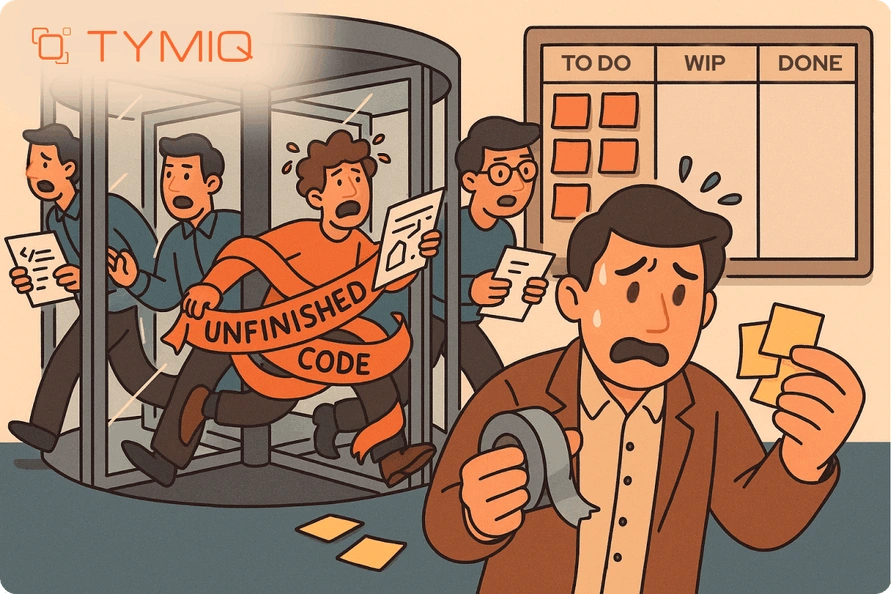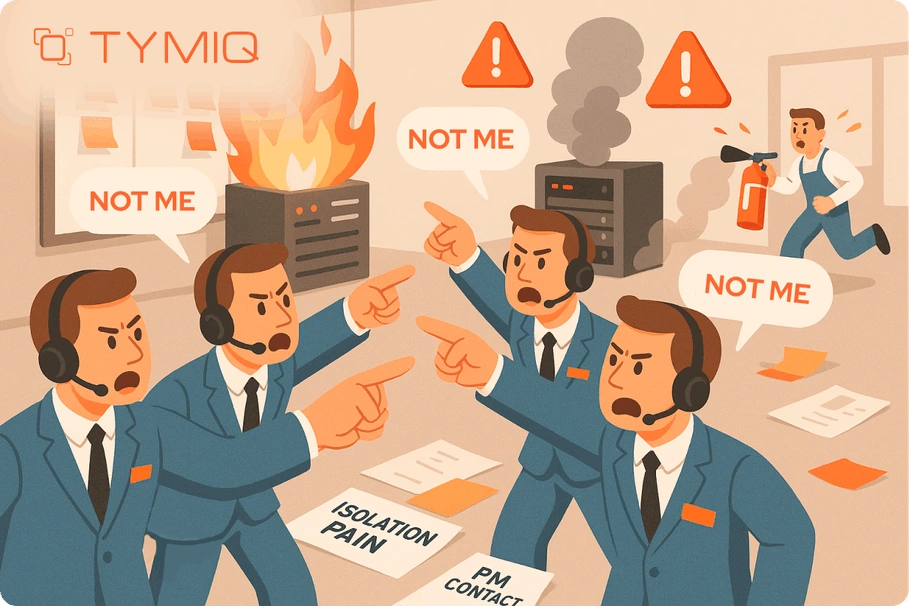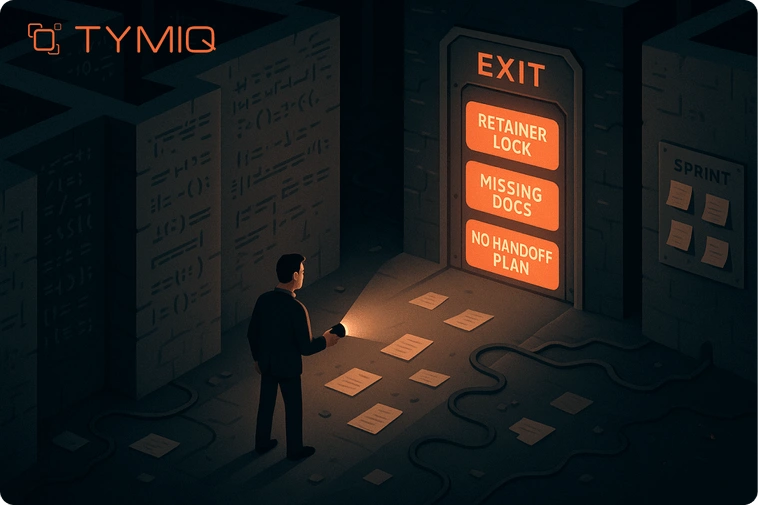CTOs don’t buy code without risk
And too often, they buy it blind.
31% of software projects get canned. Over half blow past deadlines or budgets. Not because tech is hard (it is), but because early warnings go unheeded.
Nike lost $100M on a supply chain rollout gone sideways. CrowdStrike’s 2024 patch shut down millions of systems. A Berlin startup Flux burned through €155K building a modular messaging client, but never made it past beta. Different companies met the same root cause: polished sales but broken delivery.
A red flag radar we offer is built from the real messes, covering 22 hard signals that separate confident promises from accountable partners. You’ll find these red flags in early sales calls, vague proposals, rushed estimates, and evasive answers from potential partners.
Business and domain fit

SMB story: Berlin SaaS paid €120K to a developer shop that promised a fast MVP. The vendor ghosted halfway through: no code handover, no IP agreement. To fix it, the founders had to hire another team and spend an extra €70K just to clean up and rebuild from scratch.
Technical depth and delivery

When architecture is hand-waved, delivery metrics are missing, and timelines sound too good, it's a risk in disguise.
TYMIQ case snapshots - technical depth in practice
“When we inherited a failing ATC system, the prior vendor left behind a .NET Framework repository, no tests, and undocumented logic. We rebuilt the platform on .NET Core with zero downtime across multiple live airports.”
Full service continuity, modernized stack, no service gaps.
“A legacy logistics system was causing 20-second dashboard delays across thousands of cargo events. We reengineered the platform while it stayed fully operational with no port disruptions.”
Sub-second performance, full 24/7 uptime, clean transition to scalable infra.
What to do next
- Ask for real metrics: burndown velocity, DORA benchmarks, defect density.
- Check if their estimates include QA, integration, and ramp-up, not just build time.
- If the team composition changes weekly, so will your timeline.
Pro tip: A confident vendor shares delivery metrics upfront: a risky one hides behind vague Gantt charts.
Communication and culture

You’re not buying just code, you’re buying collaboration. Misaligned communication derails even technically strong vendors with poor cadence, defensive posture, or unclear ownership.
TYMIQ case snapshots - communication that scales
“For over 9 years, we’ve delivered and maintained a fault-tolerant system serving 100+ enterprise clients. There’s a reason: shared Jira boards, integrated Slack workflows, and 24/7 on-call processes.”
Zero failed releases, enterprise-grade stability, ongoing stakeholder trust.
“Across 200+ joint projects, we embedded directly into Soxes' pipelines: joint CI/CD, DevOps, QA, and even product planning. Every ticket had shared context.”
Decade-long trust, zero knowledge loss between handoffs, parallel accountability.
What to do next
- Ensure you meet the actual PM, not just a salesperson.
- Ask how escalation happens when deliverables fall behind.
- Don’t overlook tone: defensive, unclear, or vague vendors tend to collapse under delivery stress.
Pro tip: Great vendors communicate like internal teams, asynchronously, transparently, and proactively. If your Slack stays silent, your roadmap will too.
Security and intellectual property

You can outsource development but not accountability. Poor security posture or unclear IP terms expose your business to regulatory fines, data loss, and future lock-in.
TYMIQ case snapshots - risk-proof delivery
“When we inherited an abandoned ATC display platform, there was no security compliance, no access protocol, and the original vendor had locked repository credentials.”
We established secure GitOps with permissioned access, rebuilt the environment with audit trails, and ensured IP ownership transitioned to the client from day one.
“Handling real-time emergency alerts across multiple municipalities demands rock-solid security. All work undergoes quarterly pen testing, full audit logging, and internal security code reviews.”
Over 9 years of uptime without a single critical vulnerability or compliance incident.
What to do next
- Require up-to-date security certifications, not “in progress” ones.
- Lock down source code rights in contract language before sprint one.
- Ask how incident response gets triggered and who calls it.
Pro tip: Good vendors brag about their security history. Bad ones say “trust us.”
Financial and contract

Financial opacity, vague scopes, and missing exit plans turn minor vendor issues into full-blown liabilities.
TYMIQ case snapshots - contract clarity in action
“When rebuilding the port’s legacy cargo tracking system, we tied every deliverable to payment down to feature-level acceptance. This eliminated disputes and helped us hit rollout deadlines across 3 logistics zones.”
Zero change orders, and uninterrupted delivery during live operations.
“With over 200 projects delivered jointly, our contracts with Soxes define shared CI/CD processes, IP ownership, and escalation paths. Every repository is co-managed, every sprint milestone shared, which resulted in no handovers lost in translation.”
Governance clarity beats control battles.
What to do next
- Make the exit clause a line-item, not an afterthought.
- Tie each milestone to a tangible delivery.
- Ask what happens if timelines slip.
Pro tip: If the contract says “Agile-based pricing” but offers no accountability language, assume the vendor has done this before.
How to use this checklist
You don’t need 22 out of 22 to walk away. Just three 4s or 5s on severity? That’s your cue.
This is about pattern recognition. Most bad vendor stories follow the same plot:
A rushed decision. A few ignored flags. A mounting pile of small misses that becomes a big failure.
This checklist is how you stop that script from repeating on your watch.
How to use in practice
- Pick your must-have 10. Every org is different, but vague SOWs, weak delivery history, and missing KPIs are nearly universal no-gos.
- Rate severity from 1 to 5 points for each red flag.
- Flag ≥3 scores of 4 or higher? You need a new finalist.
- Still unsure? Run a short paid pilot with exit rights and vet outcomes, not promises.
Founder tip
A smart vendor choice isn’t just about saving budget. It’s how you protect roadmap continuity, your team’s bandwidth, and the trust your customers place in your brand. In 2025, that’s real strategic insurance.











.svg)

